Development and Peace – Caritas Canada was established in 1967 by the Canadian Conference of Catholic Bishops in response to Pope Paul VI’s call to Catholics living in developed nations “to be in the first ranks of those who spare no effort to have just and fair laws, based on moral precepts, established among all nations.” (Populorum Progressio, 81).
Peace cannot be seen simply as the absence of war. It must be built daily, and it must strive towards a more perfect justice among human beings (Populorum Progressio, 76). That founding principle of Development and Peace is still maintained today.
Discover the milestones in our history and in our work in Canada and around the world with this video:
The United Nations declares that the 1960s will be the Decade of Development. It is an era of great hope but even greater naiveté as governments and institutions set out to put the Global South on a path to economic growth.
In Canada, important institutions like the Canadian International Development Agency (CIDA) and the Canadian Council for International Co-operation (CCIC) are created. The spontaneity and optimism of the moment is evident in “Miles for Millions” walk-a-thons organized across the country to raise money for Canada’s international aid effort.
From 1962 to 1965 the Second Vatican Council gathers the bishops of the world to make changes to Church practice and study ‘the signs of the times.’ The chief concerns of bishops from the Global South are the poverty, hunger and disease that kill millions of people. They insist the Church become a true Church of the Poor. This leads to an unexpected and remarkable document: “The Church in the Modern World.” Pope Paul VI’s subsequent encyclical Populorum Progressio boldly declares that “Development is the new name for peace.”
The bishops of Canada, hearing the cry of the poor, and inspired by what they call “History’s Greatest Challenge,” create the Canadian Catholic Organization for Development and Peace in 1967.


Development and Peace – Caritas Canada (DPCC) is founded by the Canadian Conference of Catholic Bishops.
The collection raises $1.35 million for 77 projects in 32 countries.
The genocidal civil war in Nigeria causes the death of 2 million Biafran civilians due to fighting and famine. The Canadian bishops ask Development and Peace to conduct a special emergency appeal.
Former Prime Minister Lester Pearson pleads with rich nations to contribute 0.7% of their Gross National Income to aid developing nations. Inspired by this call, the Catholic Women’s League asks its members to give 1% of their luxury purchases to Development and Peace as well as donating 1% of all funds raised by their parish councils.


The Vietnam War galvanizes the world’s attention for more than a decade. It ends in 1975, but this does not signal an end to all conflicts. The Cold War between the USA and the USSR is acted out through regional and country conflicts. Most Latin American dictatorships express loyalty to one side or the other of the conflict. Elsewhere, countries are forced to choose sides.
In all parts of the Global South, governments violently suppress dissent. One-party rule silences opposition in Communist Eastern Europe. Death squads roam the streets of El Salvador. Apartheid openly denies equality between white and black South Africans. The dictator Marcos declares martial law in the Philippines. To resist these forms of oppression, people’s movements rise up and seek global solidarity.
Development and Peace takes a stand with the poor and oppressed in their struggles for liberation. Allies include Church lea ders Dom Helder Camara of Brazil, Oscar Romero of El Salvador, Bishop Labayen of the Philippines, Bishops Tutu and Hurley of South Africa and the Peruvian priest Gustavo Gutiérrez, who publishes A Theology of Liberation.
The understanding that underdevelopment is a provoked phenomenon guides a new approach to development work.
Development and Peace draws on the principles of Catholic social teaching to guide its work, particularly the preferential option for the poor, which becomes the heart of its action.
Co-founded by Development and Peace and Australian Catholic Relief, the partnership comprises 21 Catholic development organizations from Asia, Europe, North America and Oceania. They recognize that local groups must be the principal actors in their own development and forever alter the donor-beneficiary relationship in favour of partnership.
In response to the unscrupulous practice of peasants being evicted from their land in the name of development, the Bishops’ Conference of Brazil creates the Pastoral Land Commission (CPT), which becomes an important Development and Peace partner.
A Time to Act - a national Christmas card campaign is organized. Cards are sent to South African political prisoners. The campaign is a precursor to the annual Fall Education and Action campaign.
A letter writing campaign supports the Grandmothers of the Plaza de Mayo in Argentina, women whose children and grandchildren disappeared under the military dictatorship.


The world sees great socioeconomic change due to advances in technology and the beginning of globalization. As economic liberalization increases in the industrialized world, many multinational corporations relocate their manufacturing to Asia and Mexico. Developing countries around the world face economic and social difficulties as they endure multiple debt crises, leading them to apply for financial assistance from the International Monetary Fund and the World Bank.
Military and dictatorial governments continue to oppress populations in Latin America. Some Church leaders publicly oppose these regimes and help to organize resistance movements. The murder of Archbishop Oscar Romero in El Salvador shocks the world and causes a public outcry against the brutality of these military dictatorships.
A widespread famine forces Ethiopia and other African countries to rely on outside aid to feed their people.
At the end of the decade, the global movement against apartheid culminates in actions that target the racist policies of the South African government.
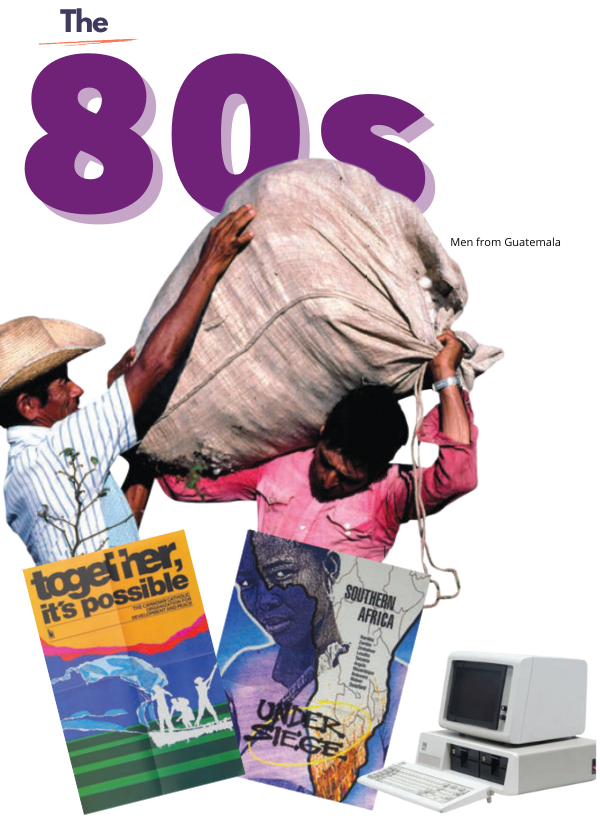

An urgent appeal demands respect for the rights of Guatemala’s Indigenous peoples and opposes the country’s military dictatorship.
The first three-year education and action campaign of Development and Peace — Caritas Canada.
A computer system is installed for the Administration Department. The digital revolution has begun.
Famine compounded by government abuse and neglect kills 400,000 people in northern Ethiopia alone. The governments of Canada and Quebec launch an emergency appeal with the result that DPCC raises $20 million to aid those most affected.
This 25-hour education and fundraising fast is still held in many schools and parishes across the country.
The campaign Southern Africa: Under Siege raises 120,000 signatures requesting that the Canadian government increase sanctions against South Africa.
With the waning of the Cold War and the success of liberation movements, many countries are able to throw off oppressive military dictatorships. Despite the spread of democratic ideals, numerous countries experience a new kind of oppression: debt. By the mid-1990s the countries of sub-Saharan Africa are paying $10 billion each year on debt interest alone. This is four times as much as they spend on health care and education combined.
The International Monetary Fund and the World Bank promote structural readjustment programs that force countries to pay their debts by privatizing public works and natural resources. In Bolivia, this leads to the Cochabamba Water War, a rebellion by the local population against attempts to privatize public water systems.
The Rwandan genocide and Hurricane Mitch elicit great compassion from Canadians. Development and Peace increasingly favours a long-term approach in its response to humanitarian crises, and supports projects run by local people.
In this decade, the Nobel Peace Prize is awarded to Nelson Mandela, Rigoberta Menchu of Guatemala and Bishop Carlos Belo of Timor-Leste, who all received support for their work from Development and Peace. Their prizes recognize significant steps towards peace in their homelands.
Nelson Mandela is released from prison. He subsequently thanks Development and Peace members for their support and the organization’s Executive Director Gabrielle Lachance is named to the board of the Nelson Mandela Fund.
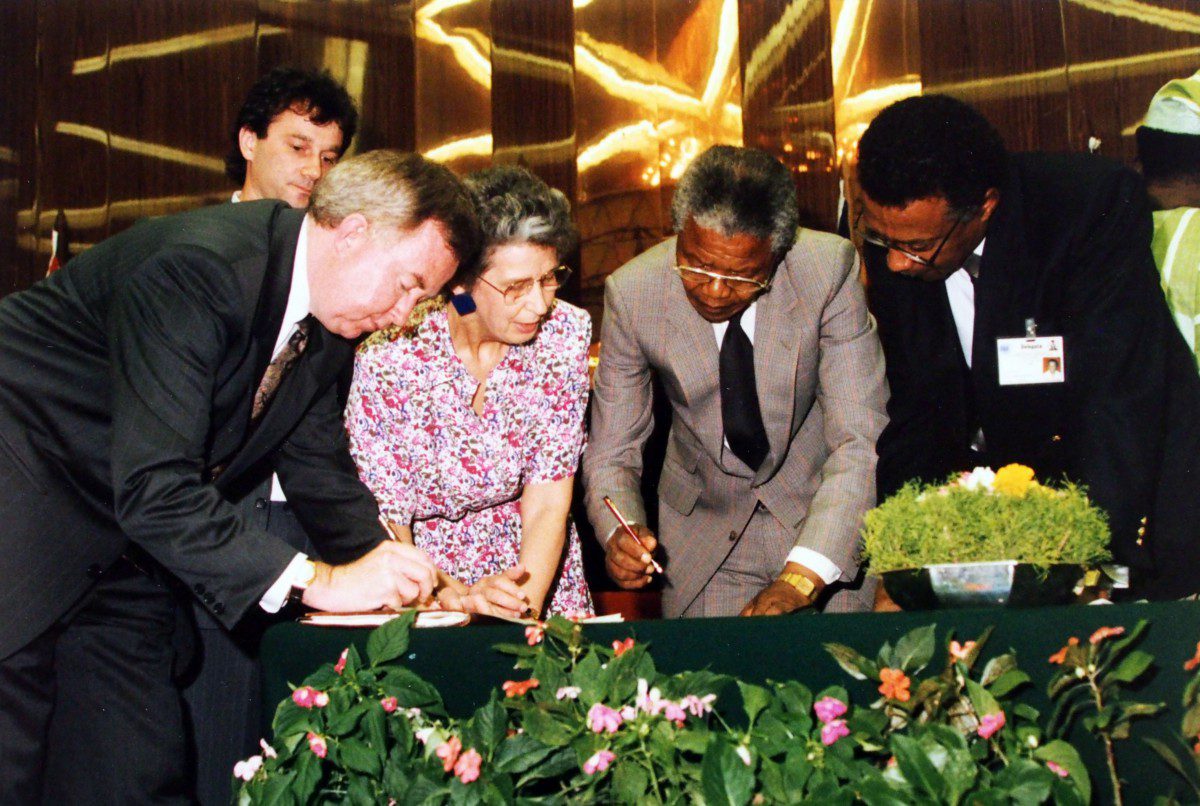

The Indigenous rights movement grows. Rebuilding the Americas is a three-year program that prepares Canadians to think and act on the meaning of the 500th anniversary of the “discovery” of America.
The Rwandan genocide results in the deaths of 800,000 children, women and men, including Development and Peace partners. A new program focuses on reconstruction and reconciliation through the country’s greatest asset: its people.
This campaign calls on Nike and Levi-Strauss to enforce and monitor Codes of Conduct in “sweatshops” where their apparel is made.
Hurricane Mitch kills 20,000 Central Americans. An emergency appeal chaired by Cardinal Jean-Claude Turcotte raises $11 million to help survivors.
The Canadian Ecumenical Jubilee Initiative (CEJI), with the support of Development and Peace, raises 640,000 signatures to cancel the debts of the world’s poorest countries. This is the largest number of signatures collected in Canadian history.
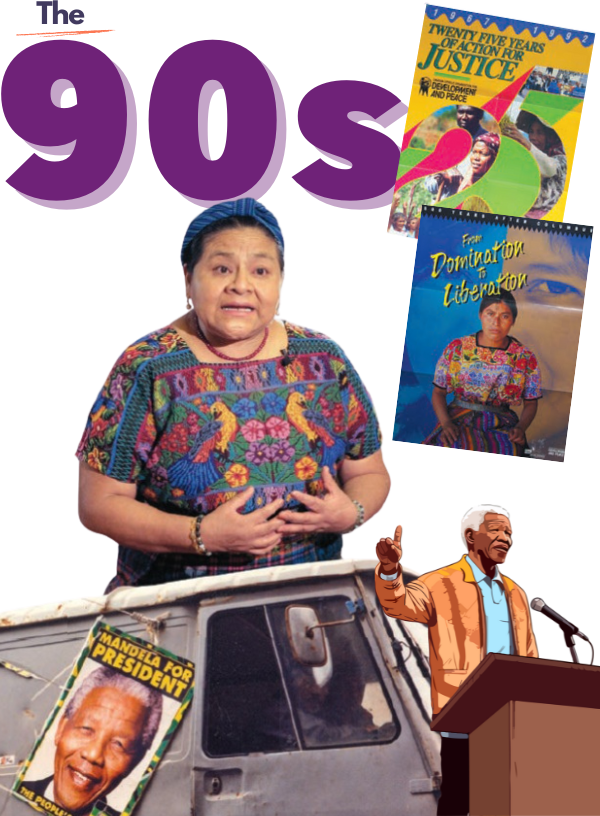

Guatemalan Indigenous activist Rigoberta Menchu and Nelson Mandela, who both received support from Development and Peace — Caritas Canada, become Nobel Peace Prize recipients.
The first World Social Forum is held in 2001 in Brazil. This gathering of civil society groups reflects a strengthening of networks searching for alternatives to the dominant neoliberal model of economic growth.
Climate change is recognized as a real and human-caused phenomenon that could greatly impact the future of the world and its inhabitants.
The 9/11 attacks in 2001 and reprisals by Western governments make Middle Eastern peace more elusive. The invasions of Iraq and Afghanistan heighten regional tensions and help the spread of radical Islam. Development and Peace expands its program in the Middle East as the crisis intensifies. The participation of the most excluded, including women, is encouraged.
The economic model of growth and consumption spurs the unfettered exploitation and control of natural resources. Peasant and Indigenous communities, in particular, experience forced evictions from their lands, impoverishment, violence and destruction of their natural environment. Human rights violations by Canadian mining companies are reported by communities from all parts of the world. In addition to mining and the patenting of seeds, the commodification and privatization of water galvanizes Development and Peace members into action on corporate social accountability.
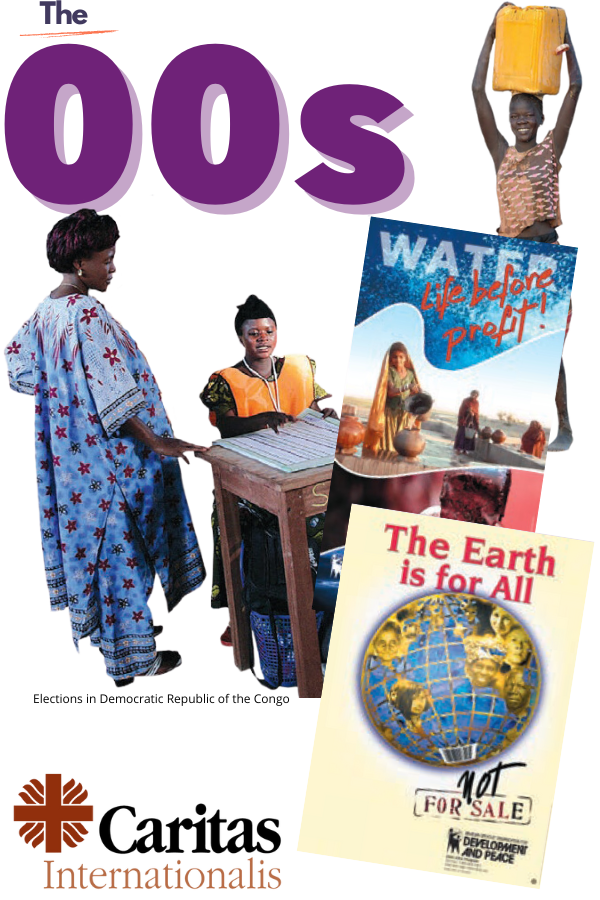

This three-year campaign critiques international financial institutions that exert control over countries of the Global South. The bio-patenting of seeds and its effect on the livelihoods of the world’s farmers is one of the issues exposed.
Development and Peace becomes the official Canadian member of Caritas Internationalis.
After years of violent struggle, Timor-Leste declares independence from Indonesia. Development and Peace develops a program focused on strengthening democracy and human rights in this new country in partnership with local organizations that were involved in the struggle for independence.
This series of campaigns tackles the looting of natural resources by foreign and private companies, specifically water, land and mining.
The Indian Ocean tsunami kills 300,000. An outpouring of generosity by Canadians results in $21 million for relief and reconstruction efforts.
The first free elections take place in the Democratic Republic of the Congo. Development and Peace works with the national Church to ensure a fair electoral process and encourage citizen participation.
The Arab Spring begins in 2010 with the Tunisian Revolution and spreads to many Arab League countries. In some countries civilian demonstrations and protests are met by government violence. In Syria, thousands of people die and millions flee civil war, creating the largest refugee crisis since WWII, affecting not only the entire region but many European nations.
In 2011, significant funding cuts affect Development and Peace and many other Canadian international development organizations. Canadian economic interests become the primary focus of Canada’s official development assistance. In March 2013, the Conservative government announces that CIDA will be folded into the newly-created Department of Foreign Affairs, Trade and Development.
The election of Pope Francis in 2013 brings a renewed focus on the poor. His encyclical Laudato Si’ : On Care for Our Common Home, inspires the entire world. Development and Peace responds to the call of the Pope and launches a campaign on climate change and its impact on the poor and most vulnerable in the lead up to the Paris Conference on Climate, COP21.
Development and Peace continues to act for peace and justice with the participation of thousands of members and supporters across Canada.
An earthquake in Haiti kills more than 220,000 people and injures 300,000. Canadians donate $21 million to Development and Peace for emergency relief and reconstruction efforts. Including government aid, the total comes to more than $28.8 million.
The Water for All campaign encourages water bottle-free zones across the country. Schools continue to create these zones today.
Typhoon Haiyan devastates the central Philippines, killing 6,000. Development and Peace – Caritas Canada raises $13 million and launches a program to address the poverty, inequality and state of powerlessness that makes poor communities vulnerable to natural disasters.
The Voice for Justice campaign re-iterates the call for an ombudsman to monitor Canada’s overseas mining activities.
Thousands of Canadians make a personal pledge to reduce their carbon footprint. They ask the Prime Minister to keep the temperature rise below 2°C and shift to fossil-free energy.
Development and Peace – Caritas Canada turns 50.
30 000 people signed postcards to MPs asking Canada to address the root causes of forced migration.22,000 people walked a total of 109,614 kilometres (almost thrice the circumference of the earth).
66 000 people signed letters expressing solidarity with the threatened Mura people and seringueiros of Brazil.


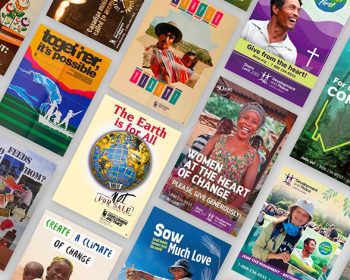

Discover the different campaigns we've run over the last few decades. Learn more.


Consult our numerous campaign, educational, theological and institutional resources.
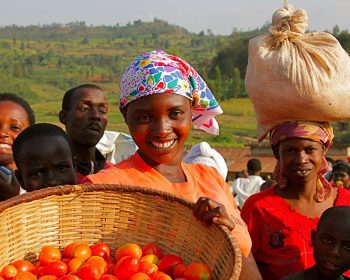

Discover our priorities and strategies for growth over the next five years (2023-2028).
About us
Our work
Get involved
Ways to give
Resources
Get in touch
555 René-Lévesque Blvd. West, 8th Floor
Montreal (Quebec) Canada H2Z 1B1
Phone: 514-257-8711
Toll-free: 1-888-234-8533
Fax: 514-257-8497
Email: info@devp.org
Website: www.devp.org
Charity number: 1 1882 9902 RR 0001


Our international cooperation program is carried out in part with the financial support of the Government of Canada acting through Global Affairs Canada.
Development and Peace — Caritas Canada is the official international solidarity organization of the Catholic Church in Canada and the Canadian member of Caritas Internationalis.
Copyrights © 2024
Don’t miss anything about the work of our international partners or our awareness and mobilization campaigns.
Sign up now for our newsletter.